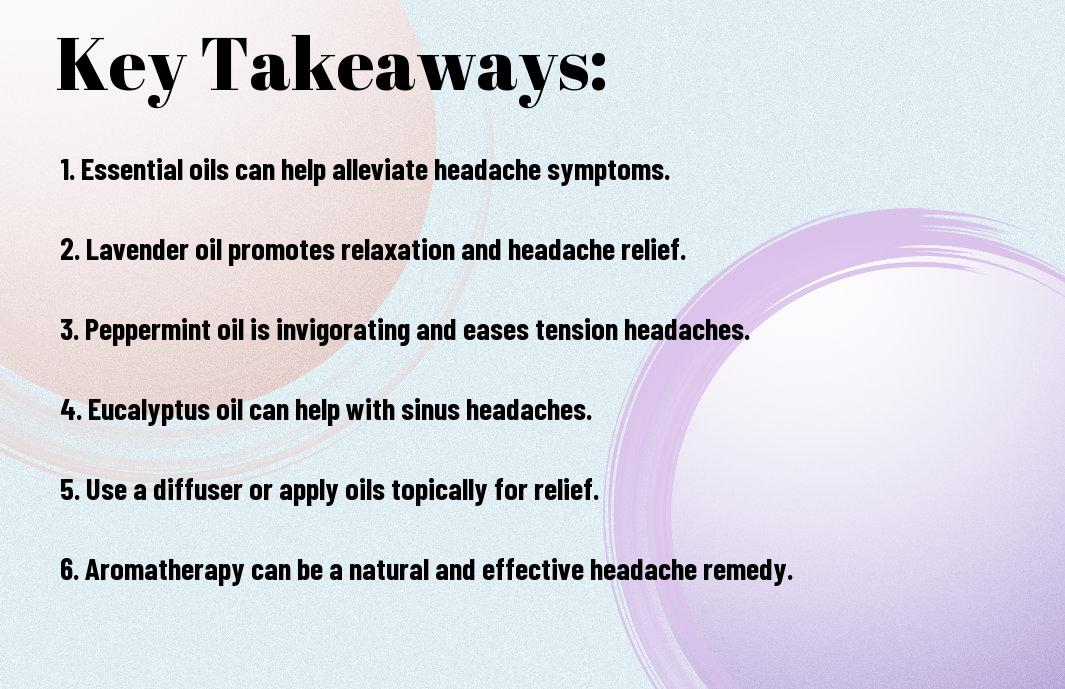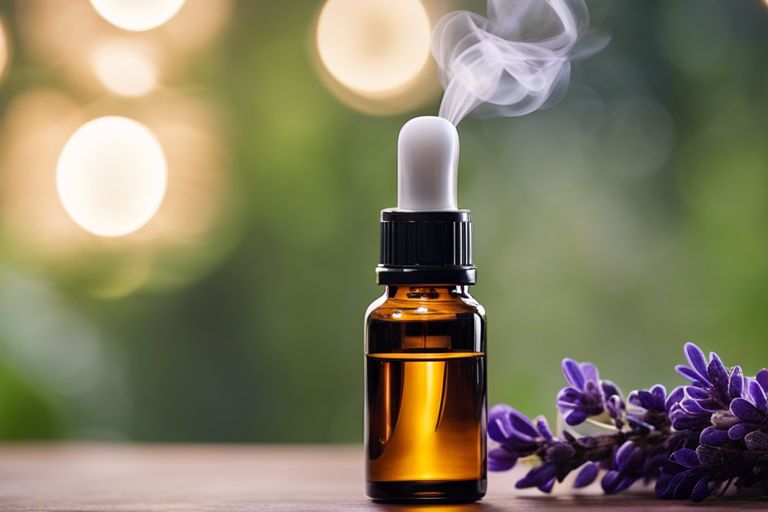Most headaches can be relieved through the natural and holistic approach of aromatherapy. By harnessing the power of necessary oils and calming scents, you can effectively alleviate the pain and tension associated with headaches. In this informative blog post, we will explore aromatherapy techniques and secret remedies to help you find relief from headaches in a gentle and soothing manner.
Key Takeaways:
- Essential oils: Using important oils like peppermint, lavender, and eucalyptus can help alleviate headaches.
- Therapeutic benefits: Aromatherapy is a natural and holistic approach to treating headaches, providing relaxation and relief from pain.
- Application methods: Diluting important oils in a carrier oil or using a diffuser are effective ways to experience the benefits of aromatherapy for headaches.
Identifying Triggers
While dealing with headaches, it’s imperative to identify the triggers that may be causing them. By recognizing these triggers, you can take steps to address them and potentially prevent future headaches.
Common Causes of Headaches
Any number of factors can contribute to the onset of headaches. These can include stress, dehydration, lack of sleep, poor posture, and certain foods or drinks. It’s crucial to track when your headaches occur and note any common patterns or behaviors that might be triggering them.
Emotional and Environmental Factors
Factors like stress, anxiety, depression, and exposure to strong smells or loud noises can also play a role in causing headaches. Pay attention to your surroundings and your emotional state when headaches strike. Assume that external factors may be influencing your headache patterns.
Common emotional and environmental triggers include daily stressors, such as work pressure or family responsibilities, as well as environmental factors like pollution or weather changes. Pay close attention to how these factors may be impacting your headache frequency and intensity. By recognizing and addressing these triggers, you can take steps towards better managing your headaches.
- Stress from work or personal life can contribute to headaches.
- Anxiety and depression can also play a role in triggering headaches.
- Exposure to strong smells or loud noises may lead to headaches.
Assume that by managing these emotional and environmental factors, you may see a reduction in the frequency and severity of your headaches.
Essential Oils for Headache Relief
One popular method of utilizing aromatherapy for headache relief is by using crucial oils. These potent extracts from plants offer a natural way to alleviate headaches and migraines.
Peppermint Oil: Cooling and Soothing
On your quest for headache relief, consider Peppermint Oil. Its cooling and soothing properties can help ease tension and reduce discomfort. By applying a diluted solution of peppermint oil to the temples, forehead, and neck, you may experience a refreshing sensation that can alleviate headache symptoms.
Lavender Oil: Calming and Relaxing
For a more calming approach to headache relief, turn to Lavender Oil. This versatile crucial oil is renowned for its relaxing properties, which can help reduce stress and tension. Inhaling the soothing aroma of lavender oil or applying it topically may provide relief from headache symptoms.
For instance, diffusing lavender oil in your bedroom before bedtime may promote relaxation and improve sleep quality, potentially reducing the frequency of headaches.
Eucalyptus Oil: Decongesting and Refreshing
Decongesting your nasal passages can be beneficial in managing headaches, especially sinus headaches. Eucalyptus Oil is known for its decongesting and refreshing properties. Inhaling eucalyptus oil or using it in a steam inhalation can help clear your sinuses and provide relief from congestion-related headaches.
A few drops of eucalyptus oil in a bowl of hot water for steam inhalation can be a simple yet effective way to reap the benefits of this powerful crucial oil for headache relief.
Blending for Success
Not all necessary oils work the same way, and blending them carefully is the key to success in relieving headaches through aromatherapy. By combining the right oils, you can create a potent blend that targets your specific symptoms effectively.
Creating Customized Blends
Blending necessary oils for headaches allows you to customize your treatment based on your preferences and needs. Whether you prefer a floral, citrusy, or woodsy aroma, mixing oils like lavender, peppermint, and eucalyptus can offer a tailored solution for your headaches.
Synergistic Effects of Oil Combinations
Blending different necessary oils can lead to a synergistic effect, enhancing the overall therapeutic benefits. For example, combining peppermint and lavender oils not only provides a pleasant scent but also amplifies their individual properties in alleviating headache symptoms. Understanding how oils interact with each other can help you create powerful blends for maximum relief.
Methods of Application
Despite the variety of important oils available for headache relief, the effectiveness of aromatherapy lies in the method of application. Understanding the different ways to use important oils can help maximize their therapeutic benefits.
Topical Use: Massage and Absorption
Absorption: Topical application involves diluting important oils with a carrier oil and applying them directly to the skin. The oils are absorbed into the bloodstream, providing direct relief to the affected area. Massaging the oils into the temples, neck, or scalp can help alleviate tension and reduce headache symptoms.
Inhalation Therapy: Direct and Indirect
An: Inhalation therapy is a popular method for using important oils to relieve headaches. Direct inhalation involves breathing in the aroma of a few drops of oil sprinkled onto a cloth or tissue. Indirect inhalation can be achieved by using a diffuser or by adding oils to a bowl of hot water to create steam. Both methods allow the aromatic compounds to enter the body and provide relief.
A: Inhaling important oils can have a quick and powerful effect on headaches, as the scent molecules travel to the brain and impact the limbic system, which controls emotions and pain perception. This can help reduce stress and tension, providing relief from headache symptoms.
Diffusion: A Gentle and Effective Approach
Indirect: Diffusing important oils is a gentle way to enjoy their benefits throughout a room. A diffuser disperses the oils into the air, allowing you to breathe in the aroma and experience their therapeutic effects. This method is particularly useful for creating a calming atmosphere and promoting relaxation, which can be beneficial for relieving headaches.
Plus, using a diffuser also helps purify the air and can enhance your overall well-being. The gentle diffusion of important oils can provide a continuous and subtle dose of their healing properties, making it a convenient and effective method for managing headaches.
Safety Precautions and Contraindications
Allergic Reactions and Skin Sensitivity
All imperative oils have the potential to cause allergic reactions or skin sensitivity in certain individuals. It is imperative to perform a patch test before using any imperative oil for the first time. Dilute a small amount of the oil in a carrier oil and apply it to a small area of skin. Wait for 24 hours to check for any adverse reactions before using it more extensively.
Pregnancy and Breastfeeding Considerations
While many imperative oils can be beneficial for headaches, pregnant and breastfeeding women should exercise caution when using aromatherapy. Safety during this delicate time is paramount, and certain oils can have adverse effects on the mother and baby. Consult with a healthcare provider before using any imperative oils during pregnancy or while breastfeeding.
With the guidance of a healthcare professional, some imperative oils may be safe to use during pregnancy and breastfeeding, while others should be avoided altogether. It’s crucial to prioritize the well-being of both the mother and the baby when incorporating aromatherapy into your routine during this special time.
Interactions with Medications and Health Conditions
Medications and certain health conditions can interact with imperative oils, potentially causing complications or reducing the effectiveness of the treatment. If you are taking any medications or have underlying health concerns, it is important to exercise precautions when using aromatherapy for headaches.
It is advisable to consult with a healthcare provider or a qualified aromatherapist before incorporating imperative oils into your routine, especially if you have existing health conditions or are taking medications. This will help ensure that the imperative oils do not interfere with your current treatment plan and are safe for you to use.
Lifestyle Changes to Enhance Aromatherapy
After incorporating aromatherapy into your daily routine to alleviate headaches, it’s important to complement this practice with lifestyle changes that promote overall well-being. By focusing on aspects such as diet and nutrition, stress management, and sleep hygiene, you can enhance the effectiveness of aromatherapy in managing headaches.
Diet and Nutrition: Fueling a Healthy Body
Nutrition: A balanced diet plays a crucial role in maintaining good health and managing headaches. Ensure you stay hydrated throughout the day, as dehydration can trigger headaches. Incorporate nutrient-rich foods like fruits, vegetables, whole grains, and lean proteins into your meals to provide your body with important vitamins and minerals.
Stress Management: Mindfulness and Relaxation Techniques
Body: Stress is a common trigger for headaches, and learning to manage stress effectively can significantly reduce their frequency and intensity. Practice mindfulness techniques such as deep breathing, meditation, and yoga to promote relaxation and alleviate tension in the body.
Another crucial aspect of stress management is engaging in activities that bring you joy and relaxation. Whether it’s spending time in nature, reading a book, or listening to calming music, find what works best for you and incorporate it into your daily routine to reduce stress levels and prevent headaches.
Sleep and Relaxation: Establishing a Healthy Routine
The quality and quantity of sleep you get can have a significant impact on your headache patterns. Establishing a consistent sleep schedule, creating a relaxing bedtime routine, and ensuring your sleep environment is conducive to rest can all contribute to better sleep quality. Avoiding caffeine and electronic devices before bedtime can also help promote a restful night’s sleep and reduce the likelihood of headaches.

To wrap up
So, armed with the knowledge of necessary oils and their therapeutic properties, you can now explore the world of aromatherapy to find relief from headaches naturally. By incorporating these aromatic oils into your daily routine, you can harness the power of nature to soothe your mind and body, promoting overall wellness and relaxation.
FAQ
Q: What is aromatherapy?
A: Aromatherapy is a holistic healing treatment that uses natural plant extracts, known as necessary oils, to promote health and well-being. These necessary oils can be inhaled, applied topically, or used in massage to alleviate various ailments, including headaches.
Q: How can aromatherapy help with headaches?
A: Aromatherapy can help with headaches by targeting the root cause of the pain and providing relief through the inhalation or topical application of specific necessary oils. These oils have properties that can reduce inflammation, relax muscles, and promote a sense of calm, ultimately easing headache symptoms.
Q: Which necessary oils are beneficial for relieving headaches?
A: Some necessary oils that are known for their headache-relieving properties include peppermint, lavender, eucalyptus, and rosemary. Peppermint oil, for example, has a cooling effect that can help alleviate tension headaches, while lavender oil has calming and stress-relieving properties that make it effective for migraine relief. Experimenting with different oils and finding what works best for you is key to effectively using aromatherapy for headaches.

